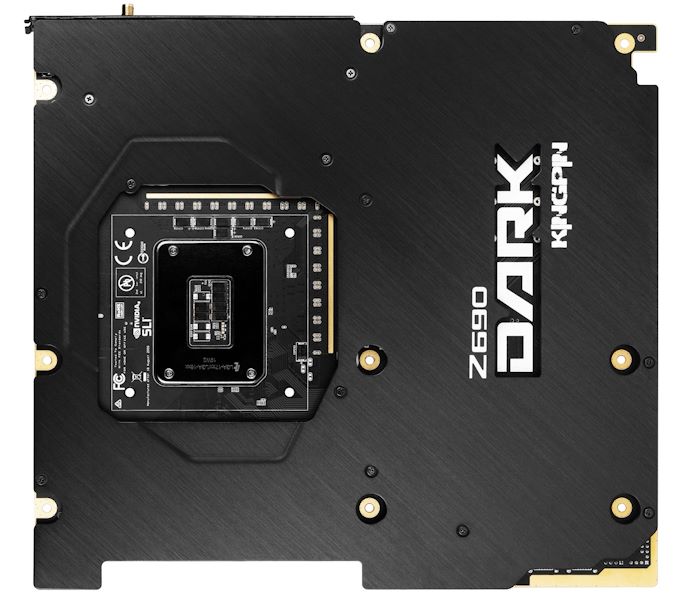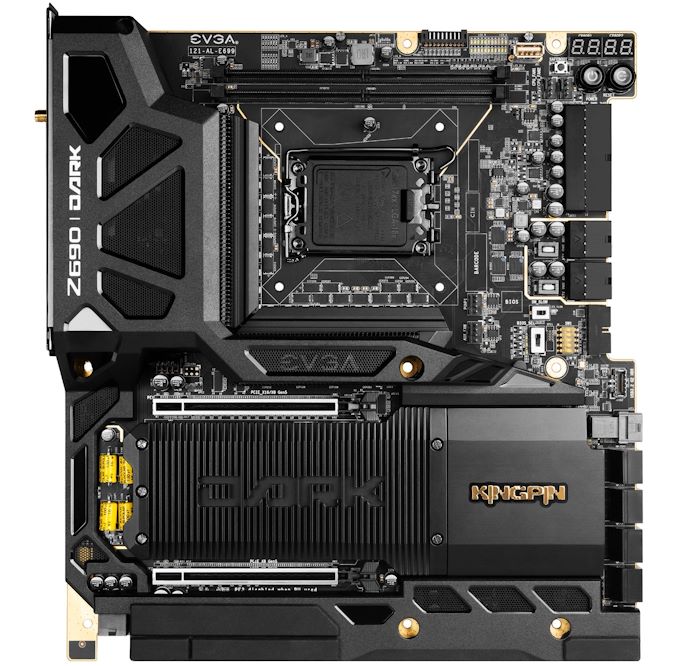The Intel Z690 Motherboard Overview (DDR5): Over 50+ New Models
by Gavin Bonshor on November 9, 2021 9:00 AM ESTEVGA Z690 DARK K|NGP|N Edition (DDR5)
Usually unveiled later on in Intel's chipset product cycles, EVGA has announced that it will be bringing two Z690 models to market sometime in the near future. The first of these is the EVGA Z690 Dark K|NGP|N edition, which is primarily geared towards extreme overclocking, just as previous versions have been. Unlike the Z590 Dark we reviewed, the Z690 model has been endorsed by legendary overclocker and in-house technician Vince Lucido.
Designed around the premium Intel Z690 chipset, the EVGA Z690 Dark K|NGP|N Edition isn't a conventional motherboard by any stretch of the imagination. It is based on the E-ATX form factor and has some interesting design characteristics including a transposed LGA1700 socket that allows extreme overclockers to mount LN2 pots with ease.
This also includes right-angled connectors including two 8-pin 12V ATX CPU power inputs, a 24-pin 12V ATX motherboard power input which intrudes into the PCB with a handy cutout designed to make cable management easier. To make the board more robust, EVGA includes a large black metal backplate on the rear of the board to reinforce the PCB, and it also includes an impressive accessories pack that features an EVGA flat test bench plate that we saw in our previous review of the EVGA Z590 Dark motherboard.
Looking at the feature set, the Z690 Dark K|NGP|N Edition includes two full-length PCIe 5.0 slots that can operate at x16 and x8/x8, with three PCIe 4.0 x4 M.2 slots that sit in between the PCIe slots and underneath a large black finned 'Dark' branded heatsink. For conventional storage and optical drives, there are eight SATA ports, six of which are from the chipset with RAID 0, 1, 5, and 10 support, as well as two that come via an ASMedia ASM1061 SATA controller.
Even though the Z690 Dark has a solid feature set for enthusiasts, the real focus by EVGA with this model is on extreme overclocking. This includes a large 21-phase power delivery cooled by an active heatsink with two fans. It also has a 10-layer PCB throughout and contains an overclocker's toolkit in the top right-hand corner that consists of dual two-digit LED debuggers, a power button, a reset button, dip-switches to disable PCIe slots, and a slow mode switch. There's also a probelt header where users can monitor voltages in real-time from various components on the board such as the CPU and power inputs.

The large black metal backplate on the rear of the EVGA Z690 Dark K|NGP|N Edition
In terms of connectivity, there's plenty on the rear panel including one USB 3.2 G2x2 Type-C, four USB 3.2 G2 Type-A, and two USB 3.2 G1 Type-A ports. For networking, EVGA is using two Intel I225-V 2.5 GbE controllers and includes Intel's latest AX211 Wi-Fi 6E CNVi. Despite a focus on performance, EVGA has also gone with a premium audio solution, including a Realtek ALC1220 HD audio codec and an EVGA NU Audio SV3H615 headphone amplifier with five 3.5 mm audio jacks and a single S/PDIF optical output.











126 Comments
View All Comments
Flying Aardvark - Wednesday, November 10, 2021 - link
"essentially any board with "Thunderbolt 3" along with USB 3.2 2x2 basically get "USB4" status for free."TB3 can run USB 4.0 devices, while USB 3.2 2x2 should be able to, it would be capped at its 20Gbit/sec and run over the backwards compatibility protocol for USB. USB4 ports can be either 20 or 40Gb.
I wouldn't want just USB 4.0 ports as Apple has, capped at 20Gbps. We'll probably see some of that on the AMD side. The best thing is just to have TB3 or TB4 to be sure you have fullspeed 40Gbps ports.
KarlKastor - Wednesday, November 10, 2021 - link
Just optional. If you have Thunderbolt and 10 Gbit USB, you can call it USB 4. See Apple.OFelix - Tuesday, November 9, 2021 - link
I agree. How come there are so few boards with USB4 or TB4 ?And how come the article doesn't mention them at all before it starts listing specific features of individual boards?
DigitalFreak - Tuesday, November 9, 2021 - link
The only way to get USB4 on a PC was by using Intel's Thunderbolt 4 chipset (or having it built into Tiger Lake). Since Thunderbolt is kind of a niche thing on desktop PCs, motherboard makers aren't interested int spending the money on Intel's TB4 chip except in high end or specialty boards. I would assume there will be some third-party USB4 chips coming soon.OFelix - Wednesday, November 10, 2021 - link
Thanks for your reply.So USB4 was built in to Tiger Lake but its not built in to Alder Lake / Z690????
That would explain somethings but not explain why on earth Intel would do that or AnandTech would not think this major regression worth mentioning!!!
The main reason I want to upgrade from my Sky Lake system (which i purchased to get built in USB3) is to get USB4/TB4.
KarlKastor - Wednesday, November 10, 2021 - link
TB is only integrated in the mobile Dies. The Desktop Die has no TB.Alistair - Tuesday, November 9, 2021 - link
DDR5 is not faster in almost every case, and there are no PCIe 5 devices (unlike when PCIe4 was launched at least you got video cards and storage immediately). Not really an advantage. Prices are too high also. Frankly I like PCIe 3.0 boards when they are under $100 USD.DigitalFreak - Tuesday, November 9, 2021 - link
It's the same thing that happened during the DDR3 to DDR4 transition. The first DDR4 products weren't really any faster than the best DDR3. Eventually DDR4 speeds got faster and left DDR3 behind. Same thing will happen with DDR4 to DDR5.Kevin G - Tuesday, November 9, 2021 - link
PCIe 4.0 support was significantly delayed on the desktop but it arrived in servers in 2017 (IBM Power9). AMD was planning on adopting PCIe 4.0 after Intel on the desktop but Intel's train wreck of their 10 nm manufacturing node derailed the chips what were going to add it (Ice Lake on desktop).I would expect both PCIe 5.0 graphics and storage by the end of 2022 on the desktop, though their benefits will be marginal outside of a few niches. (Single lane PCIe 5.0 chips for USB4/Thunderbolt 4 and 10 Gbit Ethernet vs. using four PCI 3.0 lanes are cost driven examples.)
Samus - Wednesday, November 10, 2021 - link
Kevin G - I agree, I think in a year there will be PCIe 5.0 devices, but the performance advantages, much like initial PCIe 4.0 devices (RTX 30xx, NVMe SSD's, etc) won't be there until 2023-2024, by which time this platform will already be replaced or significantly less expensive.I don't think Intel is looking to drive a lot of sales with this platform. Not many people are buying $3000 desktop PC's at the moment (and when you consider the platform alone is $500, with a $500 CPU on top of it, $3000 is pretty conservative considering most people buying something like this will want a $1000+ GPU, so that's $2000 for three components.)
Put in perspective, the last launch like this that had a lot of tech that you couldn't take advantage of right away was probably X58. PCIe 2.0 at a time no PCIe 2.0 products existed, and 36 lanes no less, left a ton of room to expand a platform that was already stacked to the gills with embedded tech. In fact it would be years before applications were fully optimized for the bandwidth offered by triple channel memory, let alone quad channel memory that Intel introduced on later HEDT platforms.
The difference though is X690 isn't even HEDT.